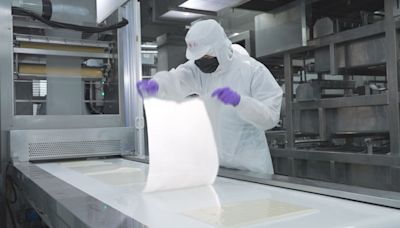搜尋結果
Bongkrek acid (also known as bongkrekic acid) is a respiratory toxin produced in fermented coconut or corn contaminated by the bacterium Burkholderia gladioli pathovar cocovenenans. It is a highly toxic, heat-stable, colorless, odorless, and highly unsaturated tricarboxylic acid that inhibits the ADP/ATP translocase, also called the mitochondrial ADP/ATP carrier, preventing ATP from leaving ...
The lactic acid bacteria (LAB) are either rod-shaped ( bacilli ), or spherical ( cocci ), and are characterized by an increased tolerance to acidity (low pH range). This aspect helps LAB to outcompete other bacteria in a natural fermentation, as they can withstand the increased acidity from organic acid production (e.g., lactic acid ).
Acetic acid / ə ˈ s iː t ɪ k /, systematically named ethanoic acid / ˌ ɛ θ ə ˈ n oʊ ɪ k /, is an acidic, colourless liquid and organic compound with the chemical formula CH 3 COOH (also written as CH 3 CO 2 H, C 2 H 4 O 2, or HC 2 H 3 O 2). Vinegar is at least 4% acetic acid by volume, making acetic acid the main component of vinegar apart from water. ...
They constitute a large domain of prokaryotic microorganisms. Typically a few micrometres in length, bacteria were among the first life forms to appear on Earth, and are present in most of its habitats. Bacteria inhabit soil, water, acidic hot springs, radioactive waste, and the deep biosphere of Earth's crust.
Methicillin-resistant Staphylococcus aureus (MRSA, often pronounced / ˈmɜːrsə / or / ɛm ɑːr ɛs eɪ / ), is one of a number of greatly feared strains of S. aureus which have become resistant to most β-lactam antibiotics. For this reason, vancomycin, a glycopeptide antibiotic, is commonly used to combat MRSA.
Below are two tables which report the average adult human height by country or geographical region. With regard to the first table, original studies and sources should be consulted for details on methodology and the exact populations measured, surveyed, or considered. With regard to the second table, these estimated figures for adult human ...
Polyethylene glycol (PEG; / ˌ p ɒ l i ˈ ɛ θ əl ˌ iː n ˈ ɡ l aɪ ˌ k ɒ l,-ˈ ɛ θ ɪ l-,-ˌ k ɔː l /) is a polyether compound derived from petroleum with many applications, from industrial manufacturing to medicine.PEG is also known as polyethylene oxide (PEO) or polyoxyethylene (POE), depending on its molecular weight. ...


